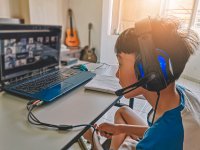How to Create Community in a Virtual Classroom
By establishing routines that address the challenges of online learning, teachers can help students in grades 3 to 8 feel a sense of belonging.
Your content has been saved!
Go to My Saved Content.Creating a strong classroom culture is priority number one during the first weeks of school. This year should not be any different—in fact, creating connections and a sense of belonging has never been more important. And yet, as coronavirus numbers soar, many schools are opting to return at least partly to remote learning in the fall. So, how can we create a positive classroom culture when we can’t even see our students face-to-face?
It’s going to take a mixture of adapting the old tried-and-true beginning-of-the-year traditions to digital media and creating whole new practices and activities.
Cyber Icebreakers
Instead of the usual round-robin name-learning games, we can ask students to share a drawing or an object that represents their personality or interests. As you move around your virtual classroom from student to student, they will hold their item or drawing offscreen while the rest of us try to remember. Students can also complete one-pagers or a Frayer Square on themselves on a shared Google Slides deck and then present to the class.
Other ideas for online icebreakers include favorite pastimes such as word games, interviewing partners in breakout rooms, and Flipgrid introductions. For the first several weeks of class, continue short get-acquainted activities. Often students enjoy a round of thumbs up/down with slide shows of foods, sports, and other images. Instead of (or in addition to) the “two truths and a lie” game, try “two objects and a lie.” That calls for students to show two objects that belong to them and one that doesn’t. After completing these activities, a fun way to cement these impressions is by playing a Kahoot! or Quizizz game about the members of your class.
Creating Classroom Rules and Expectations
Another culture-building activity is collaborating on a list of classroom rules. Since most students just had their first taste of digital learning in the spring, this is the perfect opportunity for them to use their own experiences to create a vision of how we can set up a virtual classroom that supports learning and community.
Use a plus-delta chart, so that students can indicate what worked well in remote learning in the spring and what they would like to change this school year. You can use a digital idea-sharing platform such as Mural or Google Jamboard to collaborate. This will give each student a chance to voice the positives of remote learning and to make suggestions for how we can improve it for the new year. This list of rules and expectations will then be displayed on the class’s virtual classroom wall or resource page.
Creating Class Traditions
As with in-person teaching, we can establish traditions that bind our classes together as a community in a virtual setting. Begin with a bell-ringer or a short journal-writing assignment and then ask students to share their answers. Assign students different roles such as question-asker, connection-maker, or participation-encourager.
During the spring, my students enjoyed closing class with one or two acts from a semester-long talent show or show-and-tell. I also posed a sign-off question for students to answer before disappearing from our computer screens. Examples include: What is a kind of food you like that most people don’t? Or, which superhero power would you choose? In the new school year, I plan to assign different students to create and pose their own sign-off questions.
Collaborative Projects
As we move further into the year, collaborative projects involving student voice and choice put classroom culture into practice. Service projects such as a climate change awareness campaign can work well in a virtual format. Students can also work to solve community problems, such as by creating a canned-food drive to help alleviate food insecurity.
Art projects also work well in a collaborative format. Students can create whole-class or small-group books on Google Slides on any subject or create an anthology of short fiction or poetry. They can work with a partner to create digital notebooks or reading journals that are partly written conversations among peers. Students can even work in small groups or as a class to write their own reader’s theater scripts. They can compose on a shared Google Doc and then perform virtually or create short dramatic videos that stitch together different characters’ monologues.
Forging Individual Connections
Getting to know our students as individuals in a remote setting can be challenging. One way is to facilitate individual conferences through Google Meet or Zoom. We can also take care to respond individually to students’ work through comments on Google Doc assignments or through personalized video responses to Flipgrids.
We should remember, though, that remote learning does not have to be exclusively digital. Nothing makes a student feel more valued than a teacher going out of his or her way to connect with them. Driveway visits, phone calls, letters in the mail, and drive-by celebrations are just a few of the possibilities. As an added bonus, seeing students’ faces in real life boosts teacher joy.
Even before the pandemic, young people were increasingly feeling disconnected and isolated as a result of social media and other digital distractions. This global crisis has only made the isolation worse—much worse in some cases. However, with a little creativity and willingness to adapt to new media, we can create a vital and very real sense of community in our classrooms—in any format.
